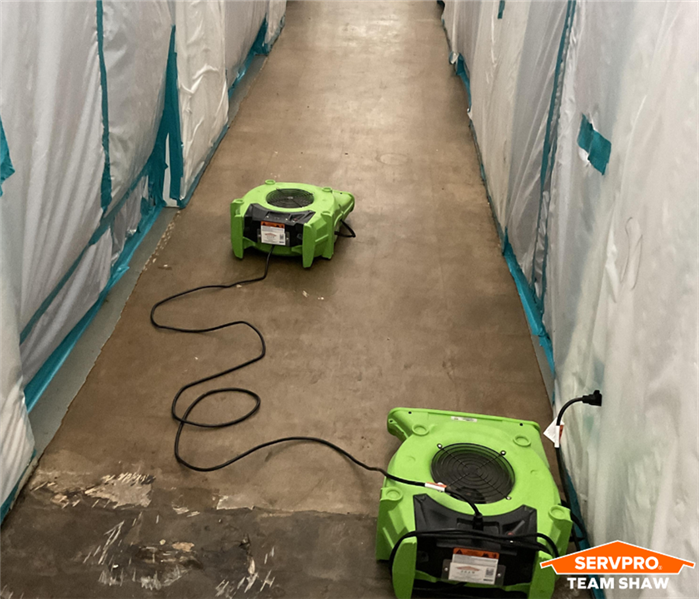10 Ways to Prevent Permanent Water Damage After Minor Indoor Flooding
10/28/2024 (Permalink)
Even a minor indoor flood can lead to major damage if not handled properly. Whether it's caused by a leaky appliance, a small plumbing issue, or an overflowing sink, quick action is essential. Team Shaw of The Woodlands has helped many homeowners recover from water incidents, and we’ve compiled the top strategies to prevent lasting damage.
Here’s what you need to know to keep your home safe and minimize the impact of minor indoor flooding.
1. Act Quickly: Time Is Everything
When it comes to water damage, every minute counts. Water spreads rapidly, seeping into flooring, walls, and furniture. The sooner you address it, the better your chances of avoiding mold growth, structural issues, and costly repairs. Start by shutting off the water source if possible and moving valuables to dry areas.
2. Use a Wet Vacuum for Immediate Water Removal
One of the quickest ways to prevent damage is to remove standing water immediately. A wet/dry vacuum can be effective for small amounts of water, but be sure to empty it frequently. Avoid using regular household vacuums, as they are not designed for water cleanup and could create electrical hazards.
3. Ventilate the Area with Air Circulation
After removing the water, proper ventilation is essential to dry out the space. Open windows and doors to allow airflow, and use fans to circulate air. For faster drying, use dehumidifiers to pull excess moisture from the air, especially in enclosed spaces like basements or bathrooms.
4. Remove Wet Carpets, Rugs, and Fabrics
Carpets, rugs, and upholstered furniture absorb water quickly and may trap moisture beneath them. Roll up wet carpets and move them to dry areas if possible. For items that can’t be removed, such as wall-to-wall carpets, consider using a professional extraction tool or calling in experts to handle the process.
5. Disinfect to Prevent Mold and Mildew
Even minor floods can create conditions for mold growth if not properly cleaned. After drying out the area, wipe down surfaces with disinfectants or antimicrobial solutions to kill bacteria and prevent mold spores from taking hold. Pay extra attention to areas like baseboards, corners, and beneath furniture where moisture tends to linger.
6. Monitor for Hidden Moisture with Detection Tools
It’s easy to miss moisture that has seeped into walls, floors, or ceilings. Use moisture meters or infrared cameras to identify areas where water might still be trapped. If left undetected, hidden moisture can weaken structures and cause mold problems over time.
7. Check and Dry Electrical Components
Water and electricity don’t mix. If your flood involved areas with outlets, wiring, or appliances, turn off the power to that part of your home and have an electrician inspect it. Avoid using electronics until you're certain they are safe.
8. Call Water Restoration Experts If Needed
If the flooding affects multiple rooms or involves porous surfaces like wood floors or drywall, consider calling a professional water restoration team. Experts like Team Shaw of The Woodlands have the tools and experience to detect hidden moisture, properly dry the area, and prevent long-term damage that could cost you more in the future.
9. Document the Damage for Insurance Claims
Even minor flooding may be covered under certain homeowner insurance policies. Take photos and keep detailed notes of the affected areas, including any damage to furniture or structural elements. Documentation will help you if you decide to file an insurance claim for repairs or water damage mitigation services.
10. Take Preventative Steps for the Future
After you’ve managed the immediate situation, think about how you can prevent future incidents. Consider installing water alarms near appliances, sump pumps in basements, and checking plumbing connections regularly. Preventative measures can save you from dealing with the same problem twice.
The Bottom Line: Quick Action Can Save You Thousands
Even a minor flood can have lasting consequences if not handled correctly. Acting quickly, removing water efficiently, and drying out the space thoroughly are critical steps to preventing permanent damage. When in doubt, professionals like Team Shaw of The Woodlands can provide expert water restoration services to ensure your home stays safe, dry, and mold-free.
Don’t let a small water incident turn into a major headache. With the right approach, you can protect your home and prevent long-term water damage from taking hold.





 24/7 Emergency Service
24/7 Emergency Service
